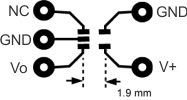SNIS106Q December 1999 – January 2015 LM20
PRODUCTION DATA.
- 1 Features
- 2 Applications
- 3 Description
- 4 Revision History
- 5 Pin Configuration and Functions
- 6 Specifications
- 7 Detailed Description
- 8 Application and Implementation
- 9 Power Supply Recommendations
- 10Layout
- 11Device and Documentation Support
- 12Mechanical, Packaging, and Orderable Information
10 Layout
10.1 Layout Guidelines
The LM20 can be easily applied in the same way as other integrated-circuit temperature sensors. It can be glued or cemented to a surface. The temperature that the LM20 is sensing is within approximately 0.02°C of the surface temperature to which the leads of the LM20 are attached.
Implementing the integrated-circuit temperature sensors presumes that the ambient air temperature is almost the same as the surface temperature; if the air temperature were much higher or lower than the surface temperature, the actual temperature measured would be at an intermediate temperature between the surface temperature and the air temperature.
To ensure good thermal conductivity, the backside of the LM20 die is directly attached to the pin 2 GND. The temperatures of the lands and traces to the other leads of the LM20 will also affect the temperature that is sensed.
Alternatively, the LM20 can be mounted inside a sealed-end metal tube, and can then be dipped into a bath or screwed into a threaded hole in a tank. As with any IC, the LM20 and accompanying wiring and circuits must be kept insulated and dry, to avoid leakage and corrosion. This is especially true if the circuit may operate at cold temperatures where condensation can occur. Printed-circuit coatings and varnishes such as a conformal coating and epoxy paints or dips are often used to ensure that moisture cannot corrode the LM20 or its connections.
10.2 Layout Examples
 Figure 11. Layout Used for No Heat Sink Measurements
Figure 11. Layout Used for No Heat Sink Measurements
 Figure 12. Layout Used for Measurements With Small Heat Sink
Figure 12. Layout Used for Measurements With Small Heat Sink
10.3 Thermal Considerations
The thermal resistance junction to ambient (RθJA) is the parameter used to calculate the rise of a device junction temperature due to its power dissipation. For the LM20, the equation used to calculate the rise in the die temperature is as follows:
where
- IQ is the quiescent current and ILis the load current on the output. Because the junction temperature of LM20 is the actual temperature being measured, take care to minimize the load current that the LM20 is required to drive.
Table 5 summarizes the rise in die temperature of the LM20 without any loading and the thermal resistance for different conditions.
Table 5. Temperature Rise of LM20 Due to Self-Heating and Thermal Resistance (RΘJA)
See more Layout Examples
| SC70-5 | SC70-5 | |||
|---|---|---|---|---|
| No Heat Sink | Small Heat Sink | |||
| RθJA | TJ − TA | RθJA | TJ − TA | |
| (°C/W) | (°C) | (°C/W) | (°C) | |
| Still air | 412 | 0.2 | 350 | 0.19 |
| Moving air | 312 | 0.17 | 266 | 0.15 |
| DSBGA | ||
|---|---|---|
| No Heat Sink | ||
| RθJA | TJ − TA | |
| (°C/W) | (°C) | |
| Still air | 340 | 0.18 |